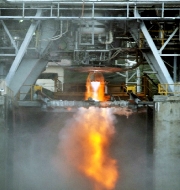HAL’s Integrated Cryogenic Engine Manufacturing Facility
President of India Droupadi Murmu recently inaugurated the Integrated Cryogenic Engine Manufacturing Facility of Hindustan Aeronautics Limited (HAL) in Bengaluru.
Key facts
- An MoU that was signed between the Indian Space Research Organisation (ISRO) and Hindustan Aeronautics Limited (HAL) in 2013 for the establishment of a facility for the manufacturing of Cryogenic Engine modules at HAL, Aerospace Division.
- This MoU was amended in 2016 for the setting up of the Integrated Cryogenic Engine Manufacturing Facility (ICMF) with an investment of Rs.208 crore.
- This state-of-the-art facility spans across an area of 4,500 square meters.
- It hosts over 70 high-tech equipment and testing facility for manufacturing cryogenic (CE20) and semi-cryogenic (SE2000) engines for Indian rockets.
- Semi-cryogenic engine uses refined kerosene instead of liquid hydrogen, which is used by cryogenic engines. Refined kerosene is lighter than liquid fuel and can be stored in normal temperature.
- The ICMF will cater to the entire rocket engineering manufacturing requirements of ISRO under one roof.
- It will boost self-reliance in manufacturing of High-thrust rocket engines.
- The indigenous development of these engines is critical for the development of rockets used for launching heavy satellites.
- Cryogenic Engine Modules are expected to be released by March next year.
- Currently, the HAL Aerospace Division manufactures liquid propellant tanks and launch vehicle structures of Polar Satellite Launch Vehicle (PSLV), Geosynchronous Satellite Launch Vehicle (GSLV) MK-II, GSLV Mk-III and stage integration for GSLV Mk-II.
What is cryogenic engine?
Cryogenic engine makes use of cryogenics, which is an outcome of the production of and behaviour of materials at an extremely low temperature. It is also called liquid-propellant rocket engines since it makes use of gases liquefied at a very low temperature. The cryogenic engine stage is the final stage of space launch vehicles. It makes use of cryogenics to store its fuel and oxidizer as liquids. The fuels are burned using oxidizer due to the lack of oxygen in space. India was able to indigenously develop this technology only in 2014. It successfully tested the cryogenic engine in 2003. In the 1990s, the US, Japan, Europe and China have stopped Soviet Union from sharing this technology with India.
Month: Current affairs - September, 2022
Category: India Nation & States Current Affairs • Science & Technology Current Affairs


